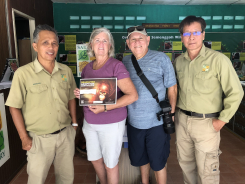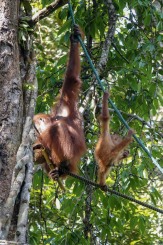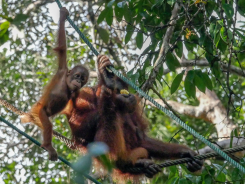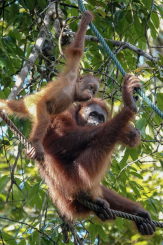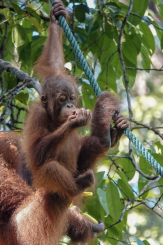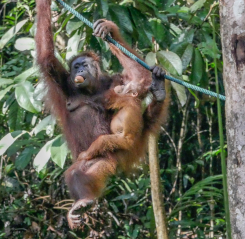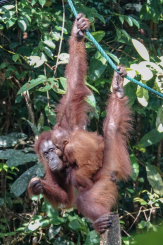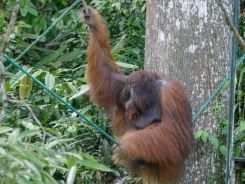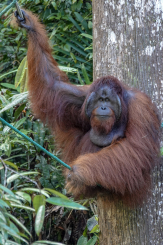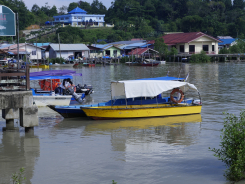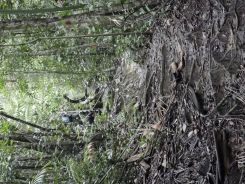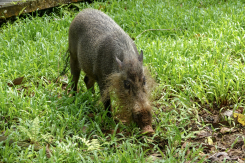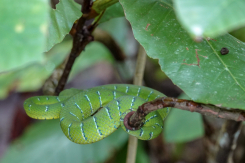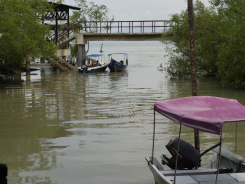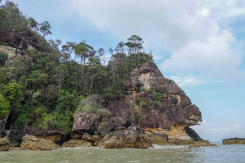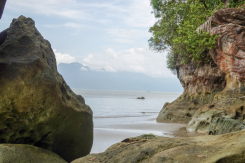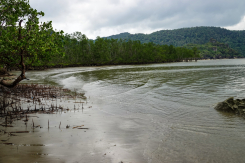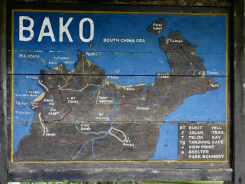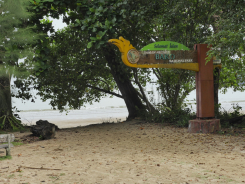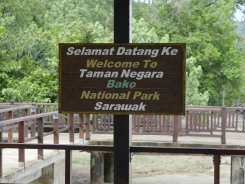Often, we use trip reports to guide our decision making process. We lean toward independent travel, but found a trip report on the benefits of hiring a guide for a trip to Bako National Park. Hmmmm. What would it say? well it was written by a person who was an independent traveler wondering why people hired guides — the trails are very well marked. But during her hike, she was bitten by a pit viper, a very poisonous snake, (and she preached since the traveling public does not know the habitats of poisonous snakes, a guide would be a wise investment, especially when they go down the trail first). We hired Geehay, an Iban tribesman. Besides a great tour of the park, and finding a pit viper, we chatted about the history of Sarawak and growing up in the jungle 50 years ago.
After disembarking from our boat, we headed along a boardwalk that snakes through a swampy mangrove area to the island proper. We did see some Proboscis monkeys, perched in trees foraging for seeds, leaves, mangrove shoots and unripe fruit; and we saw a wild boar. These Bornean Bearded Pigs dig in the ground with their snout to search for food (rooting). The extent of rooting was quite severe, and in some areas where numbers of feral pigs are high, they can uproot most of the ground surface. Then we headed into the jungle and along Telok Paku, one of the paths with reportedly good wildlife sightings and some amazing rainforest hiking.
About 45 sweaty minutes later, we come out to a secluded little beach at the end of the trail. After taking a short break to enjoy the views of the beach, we headed back to the trail head. As we came out into the open area of the mangrove, Lady Luck smiled upon us. There, sitting in some trees close to the boardwalk, were the Jimmy Durantes of the monkey world, the proboscis monkey. They were chowing down, climbing from tree to tree in search of food.
Sarawak (Kuching) also has an Orangutan Rehabilitation Center. Many wildlife species face the plight of endangerment for exploitive reasons (Palm Oil Plantations). On the other hand, many tourist attractions cage, hunt or manipulate wildlife in order to exploit them for commercial profit. As an animal lover and traveler, there had to be a middle ground of enjoying and learning about wildlife, while not endangering their well-being.
Semenggoh Wildlife Rehabilitation Centre is a 1,500 acre sanctuary established in 1975 committed to the rehabilitation of rescued and orphaned orangutans. It is not a tourist attraction, or a park to go hiking in… Semenggoh houses 28 semi-wild orangutans who are free to roam in the wild. The sanctuary is open and welcomes public to observe the orangutans only during feeding times. The rangers lead you through the forest to a raised wooden feeding area for the orangutans. Seeing orangutans is not guaranteed. If they do not make an appearance, this is actually a good thing, as it means the center has done a good job reintroducing them back to jungle life and they are able to source food in the wild.
We did see orangs; a mother and her baby, who was born in the sanctuary, and a few other apes who were taking advantage of the available food. The rangers here take their job very seriously as they throw bunches of bananas, coconuts and jackfruit are piled on the feeding platform. “We still know little about how they think and communicate,” the ranger explains, as mother and baby do somersaults. “They’re like us in so many ways, but they’re still wild creatures. Our work here is about making sure they can stay that way.”



